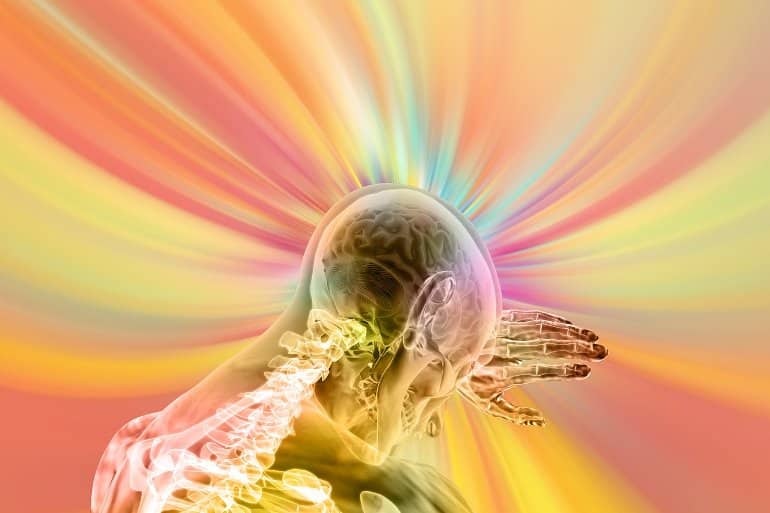Summary: Electrical stimulation of the vagus nerve promotes healing in those with acute inflammation by shifting the balance between inflammatory and anti-inflammatory molecules.
Source: Karolinska Institute
The nervous system is known to communicate with the immune system and regulate inflammation in the body. Researchers at Karolinska Institutet in Sweden now show how electrical activation of a specific nerve can promote healing in acute inflammation.
The finding, which is published in the journal PNAS, opens new ways to accelerate resolution of inflammation.
The way the body regulates inflammation is only partly understood. Previous research by Peder Olofsson’s group at Karolinska Institutet and other research groups has shown that electrical stimulation of the vagus nerve can reduce inflammation.
Such nerve stimulation has been used with encouraging results in clinical studies of patients with inflammatory bowel disease and rheumatoid arthritis. However, how nerve signals regulate active resolution of inflammation was unclear.
“We have now studied effects of signals between nerves and immune cells at the molecular level,” says April S. Caravaca, a researcher in Peder Olofsson’s group at the Department of Medicine, Solna, Karolinska Institutet and the Stockholm Center for Bioelectronic Medicine at MedTechLabs.
“A better understanding of these mechanisms will allow for more precise applications that harness the nervous system to regulate inflammation.”
The researchers showed that electrical stimulation of the vagus nerve in inflammation shifts the balance between inflammatory and specialised anti-inflammatory molecules, which promotes healing.
“Inflammation and its resolution plays a key role in a wide range of common diseases, including autoimmune diseases and cardiovascular diseases,” says Peder Olofsson.
“Our findings provide insights on how the nervous system can accelerate resolution of inflammation by activating defined signalling pathways.”

The researchers will continue to study how nerves regulate the healing of inflammation in more detail.
“The vagus nerve is only one of many nerves that regulate the immune system. We will continue to map the networks of nerves that regulate inflammation at the molecular level and study how these signals are involved in disease development,” says Dr Olofsson.
“We hope that this research will provide a better understanding of how pathological inflammation can resolve, and contribute to more effective treatments of the many inflammatory diseases, such as atherosclerosis and rheumatism.”
Funding: The study was supported by grants from the Knut and Alice Wallenberg Foundation, the Swedish Research Council, the Swedish Heart-Lung Foundation, MedTechLabs and Novo Nordisk. Peder Olofsson holds shares in Emune AB. Co-author Jesmond Dalli is the founder of and head of research at Resolomics Ltd.
About this brain stimulation and inflammation research news
Author: Press Office
Source: Karolinska Institute
Contact: Press Office – Karolinska Institute
Image: The image is in the public domain
“Vagus nerve stimulation promotes resolution of inflammation by a mechanism that involves Alox15 and requires the α7nAChR subunit” by April S. Caravaca et al. PNAS
Vagus nerve stimulation promotes resolution of inflammation by a mechanism that involves Alox15 and requires the α7nAChR subunit
Nonresolving inflammation underlies a range of chronic inflammatory diseases, and therapeutic acceleration of resolution of inflammation may improve outcomes.
Neural reflexes regulate the intensity of inflammation (for example, through signals in the vagus nerve), but whether activation of the vagus nerve promotes the resolution of inflammation in vivo has been unknown.
To investigate this, mice were subjected to electrical vagus nerve stimulation (VNS) or sham surgery at the cervical level followed by zymosan-induced peritonitis.
The duration of inflammation resolution was significantly reduced and efferocytosis was significantly increased in mice treated with VNS as compared with sham. Lipid mediator (LM) metabololipidomics revealed that mice treated with VNS had higher levels of specialized proresolving mediators (SPMs), particularly from the omega-3 docosahexaenoic (DHA) and docosapentaenoic (n-3 DPA) metabolomes, in peritoneal exudates.
VNS also shifted the ratio between proinflammatory and proresolving LMs toward a proresolving profile, but this effect by VNS was inverted in mice deficient in 12/15-lipoxgenase (Alox15), a key enzyme in this SPM biosynthesis.
The significant VNS-mediated reduction of neutrophil numbers in peritoneal exudates was absent in mice deficient in the cholinergic α7-nicotinic acetylcholine receptor subunit (α7nAChR), an essential component of the inflammatory reflex.
Thus, VNS increased local levels of SPM and accelerated resolution of inflammation in zymosan-induced peritonitis by a mechanism that involves Alox15 and requires the α7nAChR.
